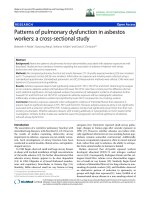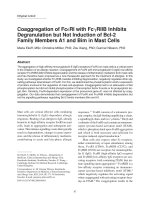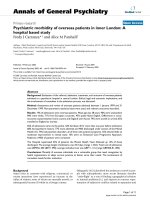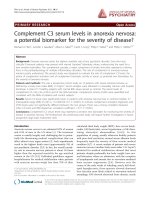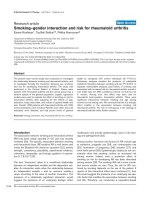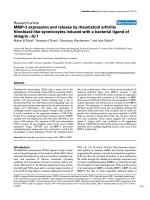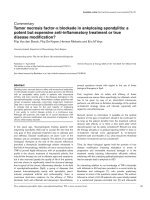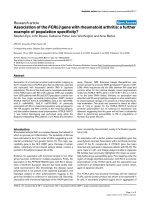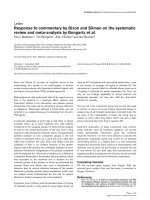Báo cáo y học: "Response to ‘Pain persists in DAS28 rheumatoid arthritis remission but not in ACR/EULAR remission: a longitudinal observational study’" potx
Bạn đang xem bản rút gọn của tài liệu. Xem và tải ngay bản đầy đủ của tài liệu tại đây (302.85 KB, 2 trang )
We read with interest the report by Lee and colleagues in
the June issue of Arthritis Research & erapy [1]. e
study compared the Disease Activity Score in 28 joints
calculated by using C-reactive protein (DAS28-CRP)
versus American College of Rheumatology/European
League Against Rheumatism (ACR/EULAR) remission in
terms of residual pain. e authors stated that DAS28-
CRP remission criteria allowed for persistence of pain in
more than 10% of patients, whereas there were very few
com plaints of pain among patients in ACR/EULAR
remission. is is a very important fi nding as it clearly
demon strated incompetence of the DAS28-CRP remis-
sion criteria in defi ning remission that is meaningful for
patients, thus encouraging transition to new ACR/
EULAR remission criteria.
One factor, however, that was not mentioned in the
article and which may be of interest is the Disease
Activity Score in 28 joints calculated by using erythrocyte
sedimentation rate (DAS28-ESR). Although the DAS28-
CRP is a validated score demon strating good correlation
with the DAS28-ESR [2], the DAS28-CRP frequently
results in lower scores than its erythrocyte sedimentation
rate counterpart [2,3]. Inoue and colleagues thus suggest-
ed a diff erent cut-off point of 2.3 for the DAS28-CRP [3].
is tendency was also demonstrated in our cohort of
265 rheumatoid arthritis patients taking biologics (Figure1).
When plotted against the DAS28-ESR, the DAS28-CRP
resulted in lower values (below the diagonal line,
indicating complete agreement) more often than not.
Also noteworthy is that the DAS28-CRP is never lower
than 0.96, which is the constant term in the following
equation [4]:
DAS28-CRP = 0.56 × √TJC28 + 0.28 ×
√SJC28 + 0.36 × ln(CRP + 1) + 0.014 × GH + 0.96
in which TJC stands for tender joint count, SJC for
swollen joint count, ln for natural logarithm, CRP for C-
reactive protein, and GH for global health as reported by
the patient.
We therefore wonder whether Lee and colleagues
performed the same analysis with DAS28-ESR remission
criteria. We think it may be interesting to perform the
same analysis with DAS28-ESR remission criteria or a
stricter DAS28-CRP cut-off point of 2.3.
© 2010 BioMed Central Ltd
Response to ‘Pain persists in DAS28 rheumatoid
arthritis remission but not in ACR/EULAR
remission: a longitudinal observational study’
Kazuki Yoshida
1
*, Kazuo Matsui
1
, Hiroto Nakano
1
, Hideto Oshikawa
1
, Masako Utsunomiya
1
, Tatsuo Kobayashi
1
,
MakikoKimura
1
, Gautam A Deshpande
2
and Mitsumasa Kishimoto
3
See related research by Lee et al., />LETTER
*Correspondence:
1
Department of Rheumatology, Kameda Medical Center, 929 Higashi-Cho,
Kamogawa City, Chiba Prefecture 296-8602, Japan
Full list of author information is available at the end of the article
Figure 1. Relationship between the Disease Activity Scores in
28 joints calculated by using C-reactive protein and erythrocyte
sedimentation rate. Relationship between the Disease Activity
Score in 28 joints calculated by using C-reactive protein (DAS28-
CRP) and the Disease Activity Score in 28 joints calculated by using
erythrocyte sedimentation rate (DAS28-ESR) in our biologic cohort.
02468
0
2
4
6
8
DAS28-CRP
DAS28-ESR
Yoshida et al. Arthritis Research & Therapy 2011, 13:405
/>© 2011 BioMed Central Ltd
Abbreviations
ACR/EULAR, American College of Rheumatology/European League Against
Rheumatism; DAS28-CRP, Disease Activity Score in 28 joints calculated by
using C-reactive protein; DAS28-ESR, Disease Activity Score in 28 joints
calculated by using erythrocyte sedimentation rate.
Competing interests
The authors declare that they have no competing interests.
Author details
1
Department of Rheumatology, Kameda Medical Center, 929 Higashi-Cho,
Kamogawa City, Chiba Prefecture 296-8602, Japan.
2
Center for Clinical
Epidemiology, St. Luke’s International Hospital, 9-1 Akashicho, Chuo-ku,
Tokyo, 104-8560, Japan.
3
Division of Allergy and Rheumatology, St. Luke’s
International Hospital, 9-1 Akashicho, Chuo-ku, Tokyo, 104-8560, Japan.
Published: 18 August 2011
References
1. Lee YC, Cui J, Lu B, Frits ML, Iannaccone CK, Shadick NA, Weinblatt ME,
Solomon DH: Pain persists in DAS28 rheumatoid arthritis remission but
not in ACR/EULAR remission: a longitudinal observational study. Arthritis
Res Ther 2011, 13:R83.
2. Wells G, Becker J-C, Teng J, Dougados M, Schi M, Smolen J, Aletaha D, van
Riel PLCM: Validation of the 28-joint Disease Activity Score (DAS28) and
European League Against Rheumatism response criteria based on
C-reactive protein against disease progression in patients with
rheumatoid arthritis, and comparison with the DAS28 based on
erythrocyte sedimentation rate. Ann Rheum Dis 2009, 68:954-960.
3. Inoue E, Yamanaka H, Hara M, Tomatsu T, Kamatani N: Comparison of
Disease Activity Score (DAS)28-erythrocyte sedimentation rate and
DAS28-C-reactive protein threshold values. Ann Rheum Dis 2007,
66:407-409.
4. DAS-SCORE.NL: Home of the DAS [ />doi:10.1186/ar3393
Cite this article as: Yoshida K, et al.: Response to ‘Pain persists in DAS28
rheumatoid arthritis remission but not in ACR/EULAR remission: a
longitudinal observational study’. Arthritis Research & Therapy 2011, 13:405.
Yoshida et al. Arthritis Research & Therapy 2011, 13:405
/>Page 2 of 2
